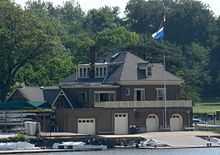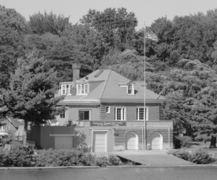Fairmount Rowing Association
| Fairmount Rowing Association | |
|---|---|
 | |
|
| |
| Location | #2 Boathouse Row, Philadelphia, Pennsylvania, U.S.A. |
| Home water | Schuylkill River |
| Established | 1877 |
| Navy admission | 1916 |
| President | John Willemin |
| Vice President | Joseph Kieffer |
| Secretary | Jim Sonzogni, Lee Silverberg |
| Treasurer | Tom Greenwood |
| Coxswain | Brian Perkins |
| Captain | Tom Toland |
| Coaches | Ahsan Iqbal |
| Lieutenants | Molly Konopka |
| Colors | Blue and White |
| Affiliations | La Salle University, Episcopal Academy |
| Website | fairmountrowing.org |
|
Fairmount Rowing Association | |
| Location | Philadelphia, Pennsylvania |
| Governing body | Local |
| Part of | Boat House Row (#87000821[1]) |
| Added to NRHP | February 27, 1987 |
Fairmount Rowing Association is an amateur rowing club, founded in 1877. The facility, located at #2 Boathouse Row in the historic Boathouse Row of Philadelphia, Pennsylvania, is on the National Register of Historic Places.[2] Fairmount originally catered to blue-collar youths living in the Fairmount neighborhood.[3] In 1916, after decades of being rejected, the club was finally allowed to join the Schuylkill Navy.[3] The Club boasts being known as the "premiere club for Masters rowing in the mid-Atlantic region"[3] and has produced several world class rowers.[4][5][6]
History of the boathouse

The structure currently known as #2 Boathouse Row is a result of a 1945 expansion project that eliminated #3 Boathouse Row by merging it into Fairmount Rowing Association’s building at #2 Boathouse Row.[3]
Pacific Barge Club
Pacific Barge Club was founded in 1859, but was not a member of the Schuylkill Navy.[7] In 1860, Pacific Barge Club built a stone cottage-style boathouse at the site of #2 Boathouse row.[7] Half of the building was occupied by the Pacific Barge Club while the other half was rented to the Philadelphia Boat Club.[7] In 1881, the Fairmount Rowing Association purchased #2 Boathouse Row and Pacific Barge Club’s equipment.[3]
In 1904, Fairmount Rowing demolished the stone building built by Pacific Barge Club. Walter Smedley, a founder of the T-Square Club, designed the Georgian Revival style Flemish bond brick structure that replaced the 1860 stone boathouse and now occupies the southern half of the Fairmount Rowing's boathouse.[3] Smedley, specialized in colonial revival residences, and also designed the Northern National Bank and the West Philadelphia Title and Trust Company.[8]
Camilla Boat Club and Quaker City Barge Club
Camilla Boat Club was a founding member of the Schuylkill Navy.[9] Camilla was a champion of the Schuylkill, but the Club disband as a result of disagreements between members.[10] In 1858, the remnants of the defunct Camilla Boat Club reorganized to form Quaker City Barge Club.[11]
By 1866, Quaker City Barge Club had purchased #3 Boathouse Row from the Pacific Barge Club.[12] Among various rowing accomplishment, Quaker City raced the first four oared boat with coxswain.[13] The Quaker City Barge Club began to decline in the 1880s and never raced in the Schuylkill Navy Regatta after 1926.[3] In 1932, the Quaker City Barge Club declared itself “inactive” in the Schuylkill Navy and became completely defunct in the 1940s.[3] In 1945, under the leadership of John Carlin, Fairmount Rowing Association bought Quaker City Barge Club's equipment and absorbed its boathouse, which now serves as the northern half of Fairmount Rowing's boathouse.[3]
-

Fairmount Rowing Association,
#2 Boathouse Row.
References
- ↑ "National Register Information System". National Register of Historic Places. National Park Service. 2007-01-23.
- ↑ NPS Focus, National Register of Historic Places, National Park Service, US Department of the Interior designating buildings 1-15 E. River Dr. (Boathouse Row) as Historic places. Search "Boat House Row" in the Resource Name box.
- ↑ 3.0 3.1 3.2 3.3 3.4 3.5 3.6 3.7 3.8 Silverberg, Lee (19 May 2008). "A Very Brief History of the Fairmount Rowing Association". Fairmount Rowing Association. Retrieved 1 May 2010.
- ↑ Teresa Z. Bell won an Olympic medal in the Lightweight Women’s Double. See Walker, Teresa M. (28 July 1996). "U.S. Rowing Women Fall Short Of Gold". Washington Post. Retrieved 1 May 2010. Bell was rowing out of Fairmount. See "Schuylkill Navy Honors Philadelphia's National Teamers". Rowing News 3 (22). 15–29 December 1996. p. 3. Retrieved 1 May 2010.
- ↑ James Castellan competed in the 1976 olympics. See Hood, Clifton R. (June 2006). "Penn in the Olympics: Penn Athletes Competing in the Olympic Games". University Archives and Records Center, University of Pennsylvania. Retrieved 1 May 2010. Castellan is a Fairmount rower. See Silverberg, Lee (19 May 2008). "A Very Brief History of the Fairmount Rowing Association". Fairmount Rowing Association. Retrieved 1 May 2010.
- ↑
- Stan Cwiklinski, 1964 US Olympic gold medalist in the Men's Eight, rowed with Fairmount until joining Vesper Boat Club in 1963. See Stan Cwiklinski sports-reference.com
- ↑ 7.0 7.1 7.2 Peverelly, Charles A. (1866). "Pacific Barge Club". The Book of American Pastimes. New York. p. 217.
- ↑ Moak, Jefferson (27 November 1983). "National Register of Historic Places Inventory--Nomination Form". NPS Focus, National Register of Historic Places, National Park Service, US Department of the Interior. p. 674. Retrieved 7 May 2010.
- ↑ Crowther, Samuel; Arthur Brown Ruhl (1905). "The Beginnings of Rowing". Rowing and Track Athletics. New York: MacMillan. p. 24.
- ↑ Peverelly, Charles A. (1866). "Quaker City Barge Club". The Book of American Pastimes. New York. p. 208.
- ↑ Kelley, Robert F. (1932). American rowing; Its Background and Traditions. G. P. Putnam's sons. p. 59.
- ↑ Peverelly, Charles A. (1866). "Quaker City Barge Club". The Book of American Pastimes. New York. p. 210.
- ↑ Heiland, Louis (1938). The Schuylkill Navy of Philadelphia, 1858 - 1937. Philadelphia: The Drake Press, Inc. p. 60.
Further reading
- "Boathouse Row". Living Places. Retrieved 30 April 2010.
- "Thomas Eakins Head of the Schuylkill Regatta 2009 Program". Thomas Eakins Head of the Schuylkill Regatta. 2009. p. 18. Retrieved 30 April 2010.
- "National Register of Historic Places Inventory--Nomination Form". NPS Focus, National Register of Historic Places, National Park Service, US Department of the Interior. 27 November 1983. pp. 659–60. Retrieved 7 May 2010.
- Burt, Nathaniel (1999). "The Schuylkill Navy". The Perennial Philadelphians: the anatomy of an American aristocracy. University of Pennsylvania Press. p. 297. ISBN 978-0-8122-1693-6.
- Heiland, Louis (1938). The Schuylkill Navy of Philadelphia, 1858 - 1937. Philadelphia: The Drake Press, Inc. p. 69.
- Janssen, Frederick W. (15 August 1888). "Quaker City Barge Club". Outing Library of Sports: American Amateur Athletic and Aquatic History 1829-1888. New York. p. 212.
- Keyser, K. C. (1872). "The Pacific Barge Club and The Quaker City Barge Club". Fairmount Park: Sketches of its Scenery, Waters, and History (5th ed.). Philadelphia: Claxton, Remsen, and Haffelfinger. pp. 131–32.
- Scharf, John Thomas; Westcott, Thompson (1884). "Public Squares, Parks, and Monuments". History of Philadelphia, 1609-1884 3. L. H. Everts & Company. p. 1871.
- Stillner, Anna (2005). The Philadelphia Girls’ Rowing Club: An Incremental Historic Structure Report (Thesis). pp. 100–01. Retrieved 30 April 2010.
- Sweeney, Joe. "The History of the Penn Athletic Club Rowing Association: Part 2 - Beginning of the Clubs". Schuylkill Navy. Retrieved 30 April 2010.
External links
- "Fairmount Rowing Association". Facebook. Retrieved 6 May 2010.
- Fairmount Rowing Association on wikimapia.org
| |||||||||||||||||||||
Coordinates: 39°58′09″N 75°11′09″W / 39.96923°N 75.18593°W
